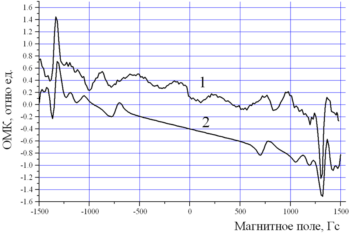Research Results 01Narrow dark resonances in the spontaneous emission of gas mixture of the even isotopes of neonThe new phenomenon – the suppression of spontaneous emission – has been observed experimentally in a gas mixture of isotopes 20Ne and 22Ne. The effect is appeared as the narrow optomagnetic resonances (OMRs) in changing of intensity of the glow of the gas mixture which was in a scanned longitudinal magnetic field. The positions of OMRs (±1400 Gs and ± 900 Gs) are defined by the resonance conditions, when the isotope shift is compensated by the Zeeman effect. The narrowness of the widths of OMRs shows diminishing of the Doppler effect, i.e. atoms of different isotopes that contribute into the resonances are in rest to each other. In these conditions there is a correlated spontaneous emission of a pair of isotopes with a reduced probability.
Isotopic OMRs are observed at low gas pressure p ≈ 0.2 mm Hg and at narrow range of pressure – Δp/p ~ 0.1. To create the OMRs the presence of both isotopes –20Ne and 22Ne are required. Resonances at ±1400 Gauss correspond to decreasing of light emission of the gas mixture. The obtained results of the experiment are in accordance with hypothesis of formation of a pair of entangled states of atoms of different isotopes of neon. Publications
|





